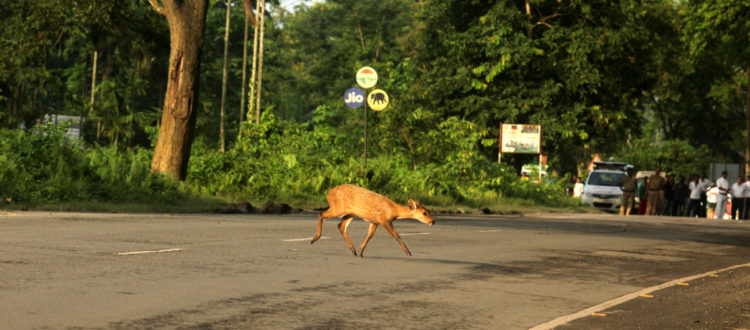When Assam Floods displace animals, humans step in to help
Kaziranga, August 23, 2019: Almost a month after the flood waters submerged 95 percent of Kaziranga National Park, the wildlife rescue centre we run near this UNESCO World Heritage Site has five new resident rhino calves. Rescued under various situations from swirling floodwaters or separated from their mothers, the rhino calves will be hand raised under set protocols at the Centre for Wildlife Rehabilitation and Conservation (CWRC) we run with Assam Forest Department (AFD) and IFAW, before they are found fit to be released back to the wild.
The River Brahmaputra floods the Kaziranga National Park every monsoon and while floods are necessary for the health of this unique ecosystem, they are detrimental to life in and around the park. As landscapes get inundated, people move to relief camps. Animals fleeing the floods need to cross the busy national highway to reach the hills of Karbi Anglong where they face life threats due to fast moving vehicles, opportunistic hunting by some locals or conflict situations when they end up in human habitation.
An injured female elephant calf was found with a fractured in a tea estate in the Borgang Range. Our team of vets approached the calf with a kumki elephant which assisted in bringing the calf out of the tea garden and onto an open area where the vets could treat the elephant. The calf was then tranquilised as the vets tended to its wounds. A few weeks later, the locals reported that the calf had moved safely to the forest.
[acx_slideshow name=”assam”]
Hog deer are the worst hit by floods. More than 80 hog deer were rescued this year from the floods. Many of these were hit by vehicles when they were attempting to get to higher ground. Such injured deer also became vulnerable to predation by dogs. Fortunately for these animals, our teams immediately reached the spots where injured deer were reported.
Floodwaters are known to separate many young rhinos from their mothers. Exhausted and unable to keep up in swirling currents, they land up in backyards of inundated homes, looking for some high ground rest on. The IFAW-WTI team tries to provide a safe passage to older calves while those below one year of age in need of hand raising are brought to CWRC for subsequent rehabilitation before release.
Two such stranded young rhinos were provided safe passage by the IFAW-WTI and AFD teams on two consecutive days in July. On 15th July, a young rhino was found fatigued and unwilling to move because of people gathered to watch and a constant movement of vehicles on the highway. The rhino was spotted near a house at Harmuti, under the Bagori range of Kaziranga NP. The rescue team i led by Dr Bhaskar Choudhury, Dr Panjit Basumatary and Dr Daoharu Baro from IFAW-WTI intervened, brought the calf near the highway and facilitated its crossing over to the Karbi hills. The team faced a similar situation the next day when another young female rhino was spotted in water near the Harmuti anti-poaching camp. In both cases, the rhinos were assisted with locally made floatation devices, held loosely with a rope and pulled along a boat to the nearest highland.
Five other rhino calves had to be brought to CWRC for hand-raising as they were below one year of age. On 16th July, a male rhino calf of nearly two months of age was rescued from Solmara area under central forest range of Kaziranga National Park by the joint team of IFAW-WTI and Kaziranga National Park. The very next day, he was joined by a female rhino calf of approximately six months of age rescued from the backyard of a fringe village house at Kuthuri near western forest range of Kaziranga National Park. The calf had to be darted by our veterinary team of Dr. Bhaskar Choudhury, Dr. Samshul Ali and Dr. Daoharu Baro. On 23rd July, a male rhino calf of approximately two to three months of age was found alone at an isolated island in the north bank of Brahmaputra and rescued by the IFAW-WTI- Kaziranga National Park team (Biswanath Division). The animal was transported to Bagori, the western forest range via Brahmaputra on a motor boat and a veterinary team of CWRC led by Dr. Panjit shifted the calf to CWRC on the same day. On 29th July, a female rhino calf of approximately two months of age was found alone and rescued near Gotonga forest camp in the western forest range of the park by the joint team of IFAW-WTI and Kaziranga National Park led by Pankaj Borah, Forest Range Officer, Western Range of Kaziranga NP. With receding flood waters on the 6th August, yet another female rhino calf was found alone from Hatimura, a riverbank of Brahmaputra under the Burhapahar forest range of Kaziranga National Park. Responding to a call, the IFAW-WTI team led by Dr. Samshul Ali visited the site and sighted the rhino calf with injury marks. She joined the four calves undergoing rehabilitation at CWRC.
The calves will be on formula milk for about a year during which they will be slowly weaned off formula. Once weaned, the calves will be moved to a suitable release site for acclimatisation to life in the wild before being eventually rehabilitated back to the wild.
Despite the intensity of floods, the number of rescues has reduced this year. This can be attributed to the increased number of highlands created by the Assam Forest Department within the park for animals to escape the flood waters; enhanced regulation of traffic on the national highway with Time Card system; intensive patrolling by the authorities and co-ordination between the forest department, civic agencies, local NGOs and communities.









